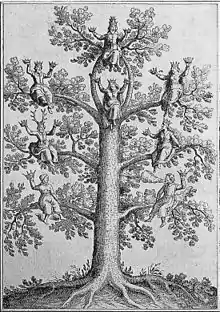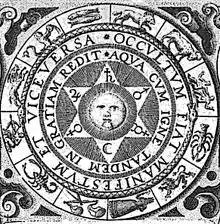
Illustration from Mylius' 1628 Anatomia auri

Illustration from Mylius' 1618 Opus medico-chymicum
Johann Daniel Mylius (c. 1583 – 1642) was a composer for the lute, and writer on alchemy. Born at Wetter in present-day Hesse, Germany, he went on to study theology and medicine at the University of Marburg. He was the brother-in-law and pupil of Johann Hartmann (1568–1613).[1]
In 1616, while still a medical student, Mylius published Duncan Burnet's Iatrochymicus.[2] The Opus medico-chymicum, Mylius' own alchemical work, was published two years later. He is known for the collection Thesaurus gratiarum (1622) of pieces for the lute.[3] In the same year his Philosophia Reformata was published.[4] Mylius was the personal physician of Moritz of Hessen and his patrons included Maurice and Frederick Henry of Nassau.
Works
- Opus medico-chymicum. 1618.
- Antidotarium. 1620.
- Philosophia reformata. 1622.
- Anatomia auri. 1628.
- Danielis Milii Pharmacopoeae spagyricae, sive Practicae universalis Galeno-chymicae libri duo. - Francofurti : Schönwetter, 1628. digital edition
References
- ↑ Debus, Allen (1990). "Chemistry and the universities in the seventeenth century". Estudos Avançados. 4 (10): 173–196. doi:10.1590/S0103-40141990000300009.
- ↑ Lynn Thorndike. History of Magic and Experimental Science, Part 12. p.177
- ↑ "Mylius 1622 Thesaurus gratiarum (list of pieces)". Archived from the original on 2016-03-03.
- ↑ "Mylius 'Philosophia Reformata' series".
External links
Wikimedia Commons has media related to Johann Daniel Mylius.
This article is issued from Wikipedia. The text is licensed under Creative Commons - Attribution - Sharealike. Additional terms may apply for the media files.